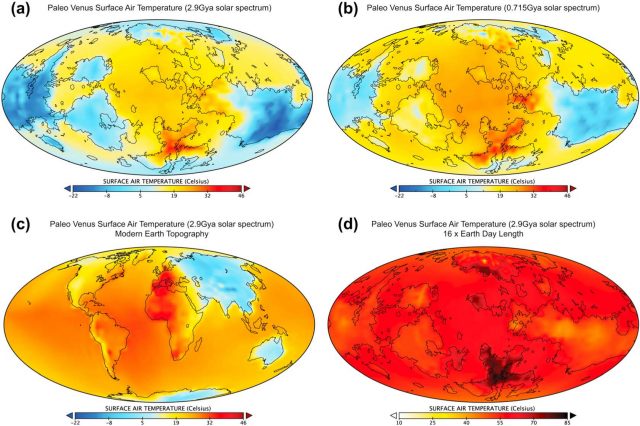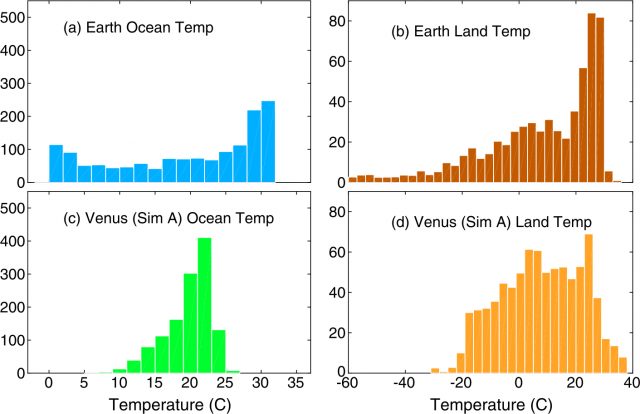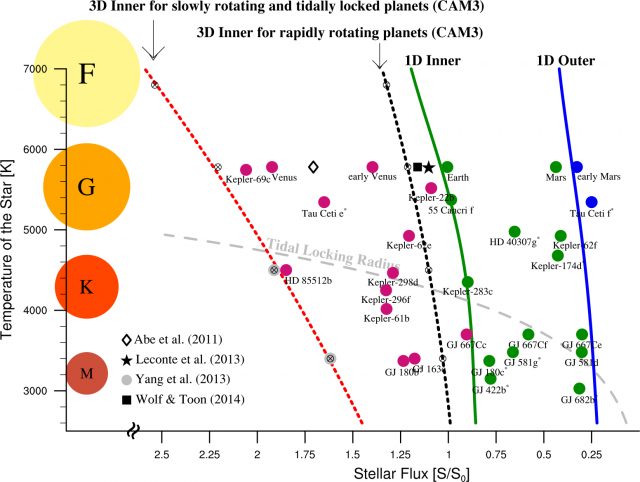Heaven from hell
So, do you think you can tell heaven from hell? Well, David Gilmour does not believe you and, to be honest, neither do I. We use to think always about the Goldilock’s limits, within which the habitability of a system is determined strictly by its parent star distance and temperature. But, even if very useful, this is a rather simplistic guess and other factors start to emerge as strong enough to be considered with our current view of confirmed planets in the Milky Way. A paper by Way and collaborators 1 has shown that Venus, the closest thing to hell in the present Solar System, might have been more like a heaven for quite a while. Their numerical simulations show a paleo Venus with mild surface temperatures, compatible with the presence of liquid water.

The idea of Venus being a wet planet in the past is not new 2. By the beginning of the 80s, it was clear that the observed D/H ratio in the atmosphere was far above that of Earth. Measurements in the following decades got quantitatively more precise but not qualitatively different. Given the reasonable assumption of Venus and the Earth having a similar initial inventory of volatiles, a greater amount of the heavy isotope was the smoking gun for an impressive loss of hydrogen and, thus, water. Back of the envelope models pointed to the possibility of having a surface ocean on Venus, and more detailed calculations backed the hypothesis. However, in what represents my favorite sequence of article names in the literature, some authors 3 claimed that the present D/H ratio could be compatible with a different story that did not require a substantial amount of water in the past.
This is a problem of sinks and sources 4. Sources might be very different in the cases of Earth and Venus and are mostly unknown in the latter. Comets are a good candidate for both but volcanism and tectonics may play a very different role, particularly if one considers the mysterious resurfacing processes operating on Venus. Moreover, the current models of Solar System formation show that there could be great inequalities in the distribution of volatiles among different bodies. The good news is that this story must be written in Venus’ stones and a mission like DAVINCI (Deep Atmosphere Venus Investigation of Noble gases, Chemistry and Imaging), pre-selected by NASA Discovery Program, could settle the issue in the next decade.
However, given the state of the art, let’s assume that Earth and Venus started with the same amount of water 5. This does not make immediately a wet planet. It requires at least two other concurring factors. First we find the so-called faint young paradox. A reduced solar flux in the past might be a problem to explain the fossil record in the Earth but it would help for a wetter paleo Venus. Current stellar models are good enough to model the solar output throughout the Solar System history and thus to make a fairly good assessment on the incoming flux at Venus at different stages of its geological life.
The final factor is the planetary rotation rate. Nowadays, the planet has a solar day of 116.75 Earth days, orbiting the Sun every 225 days with a retrograde sidereal rotation of 243 days. The orbital evolution of Venus is another controversial issue and how it acquired the present obliquity close to 180º is still debated. In any case, it is not unlikely that Venus rotated substantially slower than the Earth during most of its life.
A few years ago, a paper by Yang et al. 6
showed that rotation can play a very interesting role in planetary climate. Rotation rate controls Coriolis force, which determines atmospheric circulation which heavily influences the spatial distribution of clouds, which, finally, increases planetary albedo. In a rapidly rotating planets, clouds concentrate in a narrow band around the Equator, while slow rotators tend to have clouds widely distributed. Their simulations demonstrated that a Venus-like rotating planet could support twice as much stellar flux as an Earth-like rotator for the same surface temperature.

Now let’s take all these ingredients into the model developed by [1] et voilá, a wet Venus emerges. But wait, not that fast, things are never easy when modeling climate. Ancient topography of Venus is unknown, as well as its exact rotation state. If you consider a number of possible combinations (four in the paper discussed here), it looks like Venus could have a habitable climate until at least 0.715 Gya, provided that it had a prograde rotation slower than some 16 Earth days. And that happens even considering that solar flux would be more than one and half times greater that flux at present Earth.
Many uncertainties remains, that’s absolutely true. However, this casts a reasonable doubt over our common places on planetary habitability. Figure 3 shows how this could affect planets that have been already observed and discarded as being on the too hot side of the Goldilock’s border. This is a very moving conclusion. I recall reading Stanislaw Lem’s The Astronauts, and thinking how wrong he was about Venus atmosphere. This novel was written in 1951 and certainly was based on a naïve perspective but it might be right in a very different, unexpected sense. What if we cannot tell so easy hot air for a cool breeze?

References
- Was Venus the first habitable world of our solar system? Way et al. (2016). Geophys. Res. Lett. 43, 8376 – 8383, doi: 10.1002/2016GL069790 ↩
- Venus was wet: a measurement of the ratio of deuterium to hydrogen. Donahue et al. (1982). Science 216, 4546, 630 – 633, doi: 10.1126/science.216.4546.630 ↩
- Was Venus wet? Deuterium reconsidered. Grinspoon (1987). Science, 238, 4834, 1702 – 1704, doi: 10.1126/science.238.4834.1702 ↩
- Implications of the high D/H ratio for the sources of water in Venus’ atmosphere. Grinspoon (1993). Nature 363, 428 – 431, doi:10.1038/363428a0 ↩
- The surface and atmosphere of Venus: evolution and present state. Grinspoon (2013). in Towards Understanding the climate of Venus, ISSI Scientific Report Series 11, doi: 10.1007/978-1-4614-5064-1₃ ↩
- Strong dependence of the inner edge of the Habitable Zone on planetary rotation rate. Yang et al. (2014). The Astrophysical Journal Letters, 787:L2, doi: 10.1088/2041-8205/787/1/L2 ↩
1 comment
[…] entrada es una traducción de la original publicada en Mapping Ignorance. Si quieres leerla, pincha aquí. Esta entrada constituye también la número 100 de este blog Desde la […]